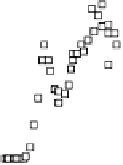Agriculture Reference
In-Depth Information
Studies of microbial growth rates indicate that
V
R
>> V
O
but
K
O1
<K
R
in
Equations (8.12) and (8.13) (van Bodegom
et al
., 2001). Hence heterotrophs will
out compete methanotrophs for O
2
except at very small O
2
concentrations.
This may constrain the spatial distribution of CH
4
oxidation in the rhizosphere.
Nutrient concentrations may also be limiting, in which case fertilizer may enhance
oxidation and lessen emissions, depending on interactions with plant growth
and other variables. Bodelier
et al
. (2000) found enhanced CH
4
oxidation in
the rice rhizosphere on adding N, contrary to expectations for aerobic soils
where it is found that methanotrophs preferentially oxidize NH
4
+
over CH
4
.
In the rice rhizosphere in flooded soil, CH
4
concentrations are much higher and,
close to roots, NH
4
+
concentrations smaller. Likewise Lu
et al
. (1999) found
diminished CH
4
emissions from rice when P was added to a P-deficient flooded
soil. Salinity also impairs CH
4
oxidation and to a greater extent than it impairs
methanogenesis (van der Gon and Neue, 1995).
Field-scale Model of Emissions
Matthews
et al
. (2000a) have developed a field-scale model of emissions based
on the above approach. In addition to the processes discussed above, the field-
scale model allows for added organic matter and soil organic matter separately,
and for the effects of inorganic terminal electron acceptors. Figure 8.4 shows that
the model was capable of predicting seasonal emissions at a particular site from
model parameter values measured independent of the emission data.
25
20
15
10
5
0
20
0
20
40
60
80
100
120
−
Time (days after planting)
Figure 8.4
Measured (points) and calculated (line) seasonal variation in CH
4
emission.
Measured data as in Figure 8.1; calculation described in text (Matthews
et al
., 2000a).
Reproduced by permission of Kluwer Academic Publishers












